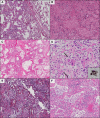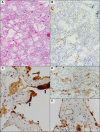Insights into pathogenesis of fatal COVID-19 pneumonia from histopathology with immunohistochemical and viral RNA studies
- PMID: 32614086
- PMCID: PMC7361244
- DOI: 10.1111/his.14201
Insights into pathogenesis of fatal COVID-19 pneumonia from histopathology with immunohistochemical and viral RNA studies
Abstract
Introduction: We describe post-mortem pulmonary histopathologic findings of COVID-19 pneumonia in patients with a spectrum of disease course, from rapid demise to prolonged hospitalisation.
Methods and results: Histopathologic findings in post-mortem lung tissue from eight patients who died from COVID-19 pneumonia were reviewed. Immunohistochemistry (IHC) and next-generation sequencing (NGS) were performed to detect virus. Diffuse alveolar damage (DAD) was seen in all cases with a spectrum of acute phase and/or organising phase. IHC with monoclonal antibodies against SARS-CoV-2 viral nucleoprotein and spike protein detected virus in areas of acute but not organising DAD, with intracellular viral antigen and RNA expression seen predominantly in patients with duration of illness less than 10 days. Major vascular findings included thrombi in medium- and large-calibre vessels, platelet microthrombi detected by CD61 IHC and fibrin microthrombi.
Conclusions: Presence of SARS-CoV-2 viral RNA by NGS early in the disease course and expression of viral antigen by IHC exclusively in the acute, but not in the organising phase of DAD, suggests that the virus may play a major role in initiating the acute lung injury of DAD, but when DAD progresses to the organising phase the virus may have been cleared from the lung by the patient's immune response. These findings suggest the possibility of a major change during the disease course of COVID-19 pneumonia that may have therapeutic implications. Frequent thrombi and microthrombi may also present potential targets for therapeutic intervention.
Keywords: COVID-19; SARS-CoV-2; diffuse alveolar damage; immunohistochemistry; lung histopathology; next-generation sequencing; thrombi; viral pneumonia.
© 2020 John Wiley & Sons Ltd.
Conflict of interest statement
The authors have no conflicts of interest to disclose.
Figures


References
-
- World Health Organisation (WHO) . Pneumonia of unknown cause – China [internet]. 2020. Updated 25 May 2020. Available at: http://www.who.int/csr/don/05‐january‐2020‐pneumonia‐of‐unkown‐cause‐chi...
-
- World Health Organisation (WHO) . Coronavirus disease (COVID‐19): Situation Report – 155 [internet]. 2020. Updated 24 June 2020. Available at: https://www.who.int/docs/default‐source/coronaviruse/situation‐reports/2...
-
- Centers for Disease Control (CDC) . Coronavirus Disease 2019 (COVID‐19): Cases, Data and Surveillance [internet]. 2020. Updated 24 June 2020. Available at: https://www.cdc.gov/coronavirus/2019‐ncov/cases‐updates/cases‐in‐us.html
-
- New York State Department of Health . Workbook: NYS‐COVID‐19‐Tracker [internet]. 2020. Updated 24 June 2020. Available at: https://covid19tracker.health.ny.gov/views/NYS‐COVID19‐Tracker/NYSDOHCOV...
MeSH terms
Substances
Grants and funding
LinkOut - more resources
Full Text Sources
Miscellaneous

